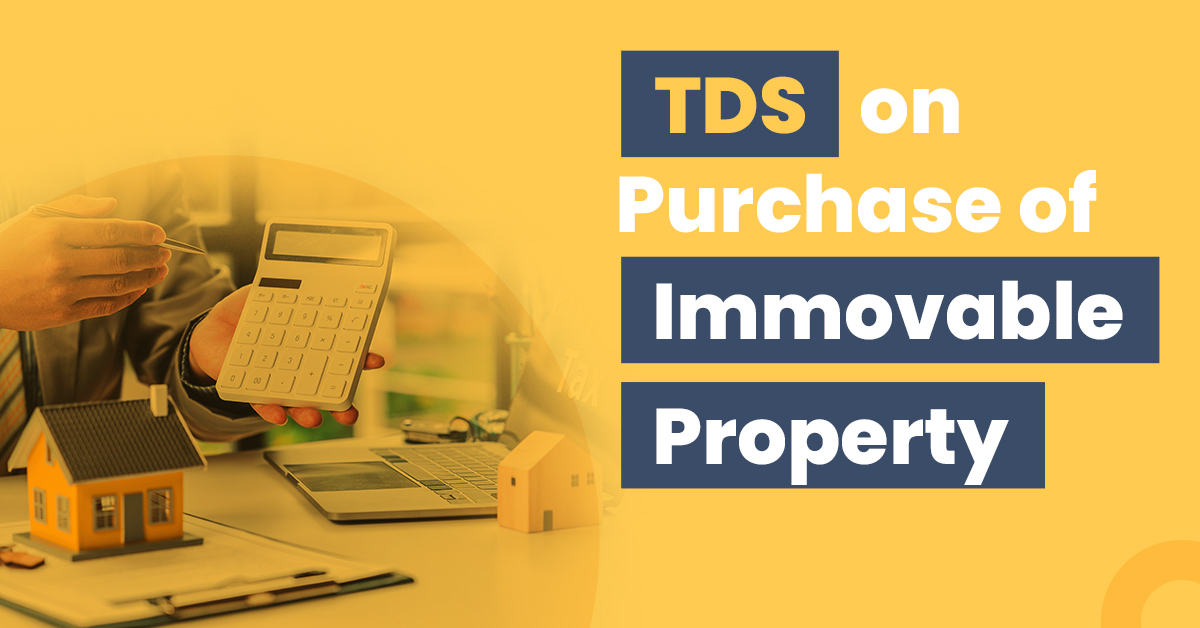Section 194IA & Form 26QB: TDS on Purchase of Immovable Property


The Indian government introduced Section 194IA under the Finance Act in 2013. It lays some ground rules that revolve around sale or purchase of immovable properties.
This guide contains detailed information on who is responsible for the tax deduction, how to deduct TDS on the purchase of immovable property, and what the deductions, the filing process, rate and time are.
What Is the Applicability of Section 194IA TDS on Purchase of Immovable Property?
Section 194IA offers a deduction on TDS at the time of purchase of immovable property. It applies to any individual who is making a payment against this purchase.
However, it is applicable only when the transaction value of the property exceeds a limit of Rs. 50 lakh. In addition, it has to be deducted while purchasing all immovable properties like commercial property, residential property, and industry, except agricultural land.
Exceptions:
- Rules regarding TDS on purchase of immovable property from a non-resident of India or NRI follow Section 195 instead of Section 194IA.
- If the transaction falls under Section 194LA (covering rules for compulsory acquisition), then the applicability of Section 194IA becomes invalid.
- On the sale of under-construction properties, a purchaser only needs to make deductions on instalments given after June 1 2013, under Section 194IA. Any instalment before the date shall contain no TDS.
When and How Much Shall be the TDS on Sale or Purchase of Immovable Property?
The purchaser must deduct TDS from the stamp value of immovable property if it exceeds its sale value. Moreover, the rate of TDS that needs to be deducted amounts to 1%. However, this percentage increases to 20%/ rate in force/ rate prescribed under the Finance act (whichever is higher) if the seller does not have a PAN number.
Example: Mr B purchases a property from Mr A, who has a valid PAN number.
Stamp Value of the Property: Rs. 55 lakh
Sale Value of the Property: Rs. 50 lakh
Calculation of TDS Amount: 1% of 55 lakh = Rs. 55,000
So, Mr B will deduct Rs. 55,000 and pay the rest, Rs. 49.45 lakh, to Mr A.
Guidelines Regarding Deposit of Deducted Tax to Government Under Form 26QB
In the example, the amount of Rs. 55,000 deducted must be deposited to the government by Mr B within the 7 days of of the next month in challan Form 26QB.
Guidelines for the Purchaser of the Immovable Property
- Purchaser must deduct a flat tax rate of 1% from the sale consideration. It will depend on the seller’s credit or the payment date.
- The online form must contain the PAN cards of both the seller and the buyer.
- A purchaser must ask for the seller’s PAN card to verify it with the original PAN Card.
- There is no method of rectifying mistakes made in filing the form online. So, buyers must be careful while filling in PAN and other information in Form 26QB.
Guideline for the Seller of the Immovable Property
- A seller must provide his/her PAN card to the purchaser to furnish in Form 26QB.
- Taxes deducted by a purchaser must be verified in Form 26AS Annual Tax Statement by the seller.
How to Pay TDS on Purchase of Immovable Property using Form 26QB?
Form 26QB is a challan cum declaration form using which the purchaser of immovable property must pay deducted tax. This credit to the government should complete within 30 days from the end of the month he/she made the deduction. There is only one way to file this form, i.e., online. The steps are as follows:
Step 1: Visit the official TIN NSDL website or click on https://www.protean-tinpan.com/.
Step 2: Click on its ‘Services’ option and select its ‘TDS on Sale of Property’ option.
Step 3: Locate and tap on ‘Online form for furnishing TDS on property (Form 26QB).’
Step 4: It will take you to a new window where you must select ‘TDS on property (Form 26QB).’
Step 5: As you click on proceed, the official form will load on your screen where you have to fill in details regarding its seller and buyer:
- PAN details
- Communication details
- Property details
- Amount paid or credited and tax details
Step 6: When you are done, submit this form to proceed. A confirmation window will appear on your screen.
Step 7: Confirm it and choose between ‘Print form 26QB’ and ‘Submit to the bank’ options. The site will send you an acknowledgement receipt which you must save for future reference.
If you click on its ‘Print form 26QB’ option, select the ‘Submit to the bank’ tab to make your payment online using internet banking.
Step 8: Proceed to find a list of banks and choose yours in particular to complete payment.
Step 9: When the process is successful, it will generate a challan counterfoil containing CIN, payment information and bank details. This serves as proof that you have made your payment.
How to Download Form 16B?
A buyer is also liable to issue a certificate of TDS in Form 16B to his/her seller within 15 days of filing with Form 26QB. The government allows to download this Form 16B online using this process:
Step 1: Register yourself and login into the TRACES portal by clicking on https://contents.tdscpc.gov.in/
Step 2: Find and select “Form 16B (for a buyer)” from the dropdown list of its ‘Downloads’ menu.
Step 3: Provide details relating to property transactions for which you need to download Form 16B. Enter details of Seller’s PAN, acknowledgement number, and assessment year, and click on ‘Proceed’.
Step 4: This site will show you a confirmation window select ‘submit request’ to proceed.
Step 5: Upon submitting, this site will show a success message that your request has been made. Note this request number to check for download requests.
Step 6: Search for ‘Requested Downloads’ to access a copy of the requested file.
Step 7: Put in your request number, select the ‘request row’ and tap on its ‘HTTP download button.’
What Are the Consequences of Failing to Submit Form 26QB and Form 16B?
As a consequence, an assessee will have to pay the following interest, and penalty amount:
Interest Applicable for Failing to Submit Form 26QB
Depending on the situation of failing to submit Form 26QB, an assessee will pay the following interest:
- Deduction for TDS Not Made
If If the assessee fails to make any deduction, he or she is liable to pay 1% interest every month or part thereof until the deduction and payment are made.
- Deduction for TDS Made but Not Paid
If an assessee deducts TDS but does not pay, he or she is liable to pay an interest rate of 1% every month or part thereof until the day it is paid.
The officials follow the calendar month while calculating interest applicable for a month. So, if an assessee delays payment even by one day of the month, interest for the entire month has to be paid. For example, Mr X deducted the TDS amount in July but paid it on August 8. So, he has to pay interest for both July and August. This means the interest will be 3%.
Penalty Applicable for Failing to Submit Form 26QB
Apart from the interest amount, a penalty of Rs. 200 per day is also levied. Assessees have to pay this penalty until their default continues. However, this amount is limited to the total TDS required to be deducted. In addition, if this penalty continues for more than one year, the assessee needs to pay an additional Rs. 10,000 to Rs. 1 lakh as a penalty as per Section 271H. The assessing officer calculates this amount.
Final Word
Individuals involved in a transaction must be mindful of the above-stated information while calculating TDS on the purchase of the immovable property. It will help avoid penalties and interest payable on the deduction amount. Also, the steps to file Form 26QB and download Form 16B will make the process easier.
Frequently Asked Questions
What is the meaning of agricultural land?
Section 194IA states agricultural land means lands in India used for agriculture. However, the land shall not be treated as agricultural land in two cases. First, this land comes under the jurisdiction of the Cantonment board or municipality with a population of not less than 10,000.
Second, this land is situated in any area whose population and distance fall under this ratio respectively: (10,000 to 1 lakh): within 2kms, (1 lakh to 10 lakh): within 6kms, (>10 lakh): within 8kms.
On what amount does TDS need to be deducted u/s 194IA?
TDS on the purchase of immovable property must be deducted on the stamp value exclusive of tax. So, if the stamp value of the sold property is Rs. 60 lakh and the GST is Rs. 60,000, TDS will be deducted on Rs. 60 lakh and not Rs. 60.6 lakh.
What counts under consideration for a transfer of any immovable property u/s 194IA?
Section 194IA states when calculating TDS on the consideration for transfer of the immovable property, it will include all types of charges. The nature of charges includes car parking, club membership, maintenance, water or electricity, advance, and other similar ones.
What happens if one does not furnish Form 16B?
The due date for furnishing Form 16B challan-cum-declaration statement is within 15 days from the date of filing Form 26QB. However, if one fails to meet this need, a penalty of Rs. 100 per day is applicable until the form is provided.




